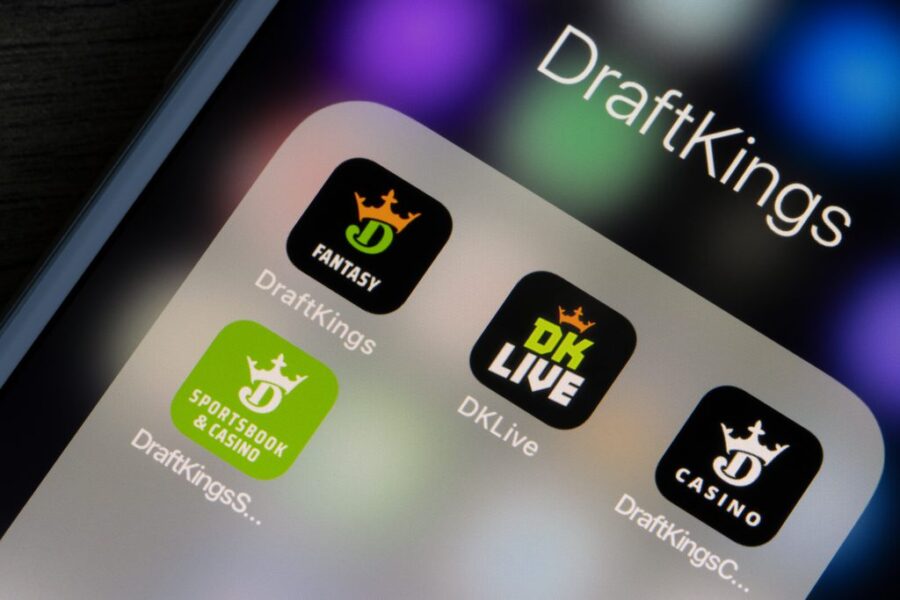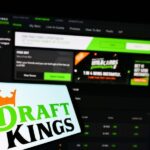Analyst sticks by DraftKings, despite dip

Evidently unconcerned by record levels of Kalshi trading volume around a Monday Night Football doubleheader, one analyst was placing a “Buy” rating on DraftKings. Jefferies Equity Research boffin David Katz shared his views in a 30 September investor note.
Katz put a US$54-per-share price target on DraftKings after a Tuesday selloff of the stock. It was trading at US$37.40 apiece at the time of his report.
The analyst reassured investors that “we do not believe the economics of prediction markets are nearly comparable to [online sports betting], with the product and technology also not comparable.” Katz felt that OSB and prediction markets could prosper alongside each other.
Kalshi had disclosed weekend handle of US$538 million, 98% of it derived from sports betting. “While an impressive figure, given Kalshi’s 2024 election night volumes totaled only US$245 million, the Street could be overreacting to volumes as it relates to OSB,” Katz opined.
He went on to point out that prediction-market volumes were but 30% of those for OSB, and that Kalshi’s OSB-equivalent handle was likelier closer to US$162 million. By contrast, in the third week of NFL play, DraftKings had stirred up handle of US$220 million just from New York State.
“Despite rapid growth, we believe Kalshi volumes still represent a fraction of [DraftKings’] handle,” Katz concluded.
Katz further noted that Kalshi’s non-gaming revenue was dwarfed by that of OSB providers. Its 2% trading fees were measured against DraftKings’ 7% margin. Nationwide, Kalshi’s fees computed to US$11 million, compared to DraftKings’ US$15 million from the Empire State alone.
“All parlays are not the same,” Katz warned. He theorized that investors were not just reacting to Kalshi’s trading volume but also to its deployment of same-game parlays or SGPs.
“Our checks indicate that these parlays were a deviation from Kalshi’s usual MO, and were potentially supported by an outside market maker (i.e., Susquehanna),” Katz reassured investors. “Furthermore, we believe these parlays lack the sophistication of traditional OSB, as the bets were only pre-game (no in-play), only same-game (no multi-game), and had comparatively little customization.”
In addition, the SGPs were limited to three legs: game result, score and who would score touchdowns on Monday night. These points also were made by Jefferies colleague James Wheatcroft, in a separate investor note on DraftKings arch rival Flutter Entertainment and its FanDuel subsidiary.
“In short, we believe the product and technology capabilities [of] leading OSB operators are well ahead of prediction offerings,” Katz asserted.
Despite the Kalshi sticker-shock news, Katz saw nothing but positive auguries for DraftKings. He pointed out that it was trending up 12% in New York State handle in the third quarter and its gross gaming revenue had risen 14% over that same period.
Outside the Empire State, gross-revenue figures were said to be even better, tracking 20% higher during July and August. Igaming also was burnishing DraftKings’ numbers, up 20% during the third quarter.
Katz summarized, “we believe that the weakness in the shares is overdone, and current levels provide an attractive entry point.”
David McKee is an award-winning journalist who has three decades of experience covering the gaming industry.
Verticals:
Sectors:
Topics:
Dig Deeper
The Backstory
Why the selloff didn’t shake the bulls
DraftKings’ latest dip has reopened the debate over whether the stock’s swings reflect fundamentals or noise. After a Tuesday selloff pushed shares to the high-$30s, Jefferies’ David Katz urged investors to look through the volatility, maintaining a Buy rating with a $54 target and arguing that prediction-market hype was distorting the picture. In an investor note, Katz contended that prediction markets and online sports betting are different businesses and can grow side by side, pointing to DraftKings’ rising handle and gross gaming revenue through the third quarter. He also emphasized that same-game parlay mechanics driving recent chatter lacked the sophistication and margins of top-tier sportsbooks. Those arguments, laid out in Jefferies’ defense of DraftKings after the selloff, underpinned a view that recent weakness offers an entry point rather than a trend break.
The company’s own tone has been similar. On the most recent earnings call, Chief Executive Jason Robins acknowledged “bad quarters” on outcomes but described them as variance, not erosion. Revenue rose 20% year over year to $1.409 billion in the first quarter, with monthly unique payers up 28%. Robins noted double-digit handle gains across March and baseball, even as April cooled. Analysts broadly framed the miss as outcome-driven, not structural. That perspective was captured in DraftKings’ results and Robins’ caution on taxes and illegal competition, which also flagged headwinds from state tax hikes and Jackpocket’s Texas exit.
Prediction markets jolted sentiment, not the model
The flashpoint came from Kalshi’s surge around an NFL Monday night doubleheader. Weekend trading volume hit $538 million, with sports-related markets accounting for most of it. Some investors extrapolated that spike into a threat to sportsbooks’ share of wallet. Katz pushed back. In his note, he recast Kalshi’s figures into sportsbook-equivalent terms, arguing the comparable handle was closer to $162 million. He contrasted that with DraftKings’ $220 million handle in New York alone in a single NFL week and highlighted margin differences: Kalshi’s 2% fee versus DraftKings’ roughly 7% sportsbook margin. He also questioned the durability of Kalshi’s same-game parlay offer, saying it appeared pregame-only, three-leg limited and likely supported by a market maker. The takeaway: impressive volume did not imply parity on product, pricing or unit economics.
Jefferies’ view echoed broader operator skepticism that the prediction format can replicate in-play depth, multi-leg optionality and personalization that drive sportsbook hold. It also underscored a tactical risk for investors: conflating headline volume with revenue quality. The episode explains why DraftKings’ bulls treated the selloff as a technical move rather than signaling a secular shift in customer behavior.
The math that keeps skeptics circling
Bulls are not unopposed. Deutsche Bank’s Carlo Santarelli has long questioned DraftKings’ path to its multiyear targets. In his April note, he said investors fixate too much on hold, which can mask tougher issues in handle growth and igaming cadence. He pointed to management’s earlier framing of 2025 revenue rising 35% to $6.3 billion–$6.6 billion, which he views as a demanding setup after a string of hold-affected quarters. To reach those levels, Santarelli argued, DraftKings needs both a lift in hold and high-teens growth in handle against slowing markets like Michigan and New Jersey, with New York’s high-tax market ironically among the better performers.
The push-pull on hold shows up in the quarter-by-quarter tape. January and February held above 10%, then March turned adverse with the NCAA tournament. Robins called that variance. Santarelli countered that luck is not a strategy and promotions remain elevated. He sees 25% igaming growth as difficult but possible, while Jackpocket adds less than first modeled after Texas. The split matters because it shapes whether 2025 guidance rests on normalization or new growth engines. The answer will drive the multiple investors ascribe to the stock more than any one monthly outcome swing.
Rivals adjust the playbook, not just the spend
Competitors are revising their mixes for profitability rather than blitzing for share. BetMGM leaned into that message on its investor call, projecting $2.4 billion–$2.5 billion in revenue this year and a positive return on investment despite wider 2024 losses. Chief Executive Adam Greenblatt described a strategic tilt to “premium mass” players and more efficient marketing, reinforced by rising igaming share and stronger fourth-quarter trends. The company is prioritizing omnichannel loyalty, live-dealer expansion and cross-sell, while de-emphasizing late-entry or shallow-penetration states. The posture, outlined in BetMGM’s bullish update despite wider losses, signals an industry pivot from pure acquisition toward value per player and cash return timelines.
That shift reverberates around DraftKings, which already carries scale leadership with FanDuel in most regulated states. If rivals chase premium yield and steady ROI, promotional intensity could ease at the margin, helping hold and unit economics. Santarelli rejects that premise for now, saying evidence of a softer promo environment is anecdotal. Still, as operators cut unprofitable channels, the competitive set may become more rational than in 2021–22. That would support bulls’ case that recent hold noise obscures healthier underlying trends.
Taxes, illegal markets and the policy squeeze
Tax policy remains the industry’s pressure point. Robins warned that sharp hikes in Illinois and Maryland push bettors to offshore sites, eroding the regulated market that states rely upon for revenue. He said DraftKings will not chase a Texas reversal on Jackpocket after the courier ban, given legislative headwinds. Those themes in DraftKings’ call were echoed by BetMGM, which told investors that high tax rates weaken onshore competitiveness and argued for legal igaming as the more durable revenue base. That stance has gained political salience as state budgets tighten.
The risks are not theoretical. A University of Mississippi survey found that nearly 60% of student gamblers placed online bets with “legal” sportsbooks, despite mobile betting being illegal statewide. Many used VPNs or cutouts. The findings, detailed in the Mississippi student betting study, suggest demand leaks across borders and into gray markets regardless of statute. For operators, the study bolsters arguments that tax and access design determine how much activity migrates offshore. For lawmakers, it raises stakes for funding addiction treatment and policing illegal providers as enforcement alone falls short.
Deal flow and strategic hedges on the periphery
M&A chatter continues as operators and adjacent players jockey for position. DraftKings left the door open to selective international deals that create clear synergies but said it does not need them. Elsewhere, Australian operator Betr Entertainment advanced a fresh share-swap proposal to take over PointsBet Holdings, pitching a higher implied value than MIXI’s cash offer. Betr urged shareholders to wait for both offers to formalize and pressed the board to reconsider its support of MIXI. The bid, outlined in Betr’s latest approach for PointsBet, underscores ongoing consolidation pressure in markets where scale, product breadth and marketing efficiency set the winners.
Prediction markets remain a watch item for incumbents. BetMGM said it will monitor the space, noting Entain’s experience in election wagering abroad, but wants a level regulatory field. That stance aligns with Katz’s view that prediction-market mechanics do not yet rival top sportsbook capabilities. For now, the backstory to the selloff reads as a case of optics overwhelming fundamentals. The next few quarters — hold normalization, promo discipline and tax policy clarity — will show if that story sticks.








